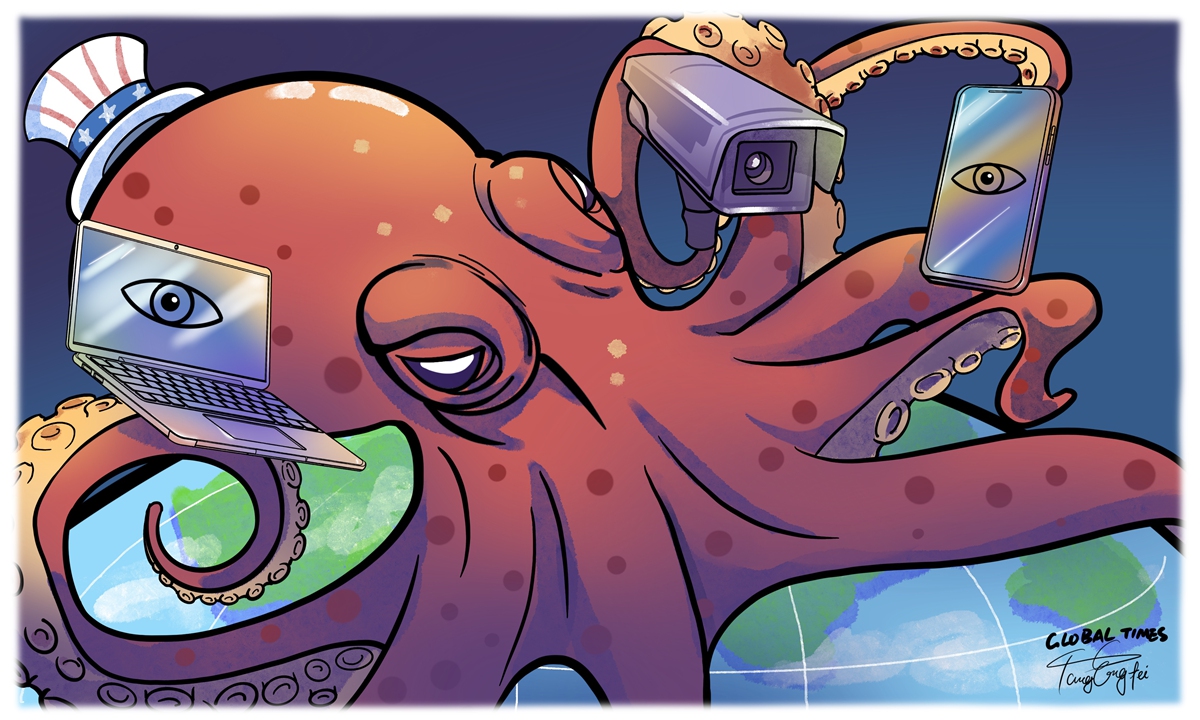
Illustration: Tang Tengfei/GT
On July 2, The Wall Street Journal (WSJ) published a so-called exclusive report claiming that a study from a Washington-based think tank Center for Strategic and International Studies (CSIS) showed that images captured from space show the growth of Cuba's electronic eavesdropping stations that are believed to be linked to China, including new construction at a previously unreported site about 70 miles from the US naval base at Guantanamo Bay. This claim has been refuted by the Cuban Deputy Foreign Minister, the spokespersons of the Chinese Ministry of Foreign Affairs and the Chinese Embassy in the US.
"Here it comes again," it is people's general reaction to this news. In June 2023, the WSJ had cited "US officials" in claiming that China and Cuba had reached a "secret agreement" for China to establish an electronic eavesdropping facility in Cuba. This report was subsequently debunked by both the White House and Cuban authorities. One has to wonder whether the WSJ, a newspaper with over a century of history, has any basic editorial and fact-checking procedures in place. The July 2 report, authored by the same journalist as last year's piece, appears oblivious to the glaring inconsistencies and contradictions between the two pieces of articles.
For instance, last year's report claimed that China and Cuba had reached an agreement "in principle" to allow the former to build the eavesdropping station in Cuba. This year's report, however, states that the "new" eavesdropping station had already begun construction as early as 2021. Moreover, the CSIS report's author claimed to have identified the spying facilities in Cuba "after analyzing years' worth of satellite imagery." However, one of the locations, referred to as "El Salao," according to the report's coordinates, actually points to the landmark building National Shrine Basilica of Our Lady of Charity del Cobre in the village of El Cobre -- which is a church.
As for how these "eavesdropping stations" are linked to China, the WSJ claimed that it is "believed" to be the case. The WSJ did not provide an explanation for this "belief," while CSIS stated it was due to China and Cuba's cooperation in space technology. This is a clear case of concocting charges without substantial evidence. The facts are murky, but the conclusions are explicit, directly targeting China.
The CSIS report further specifies that it was jointly produced by Hidden Reach and the Americas Program. The former utilizes so-called satellite imagery and open-source information to long-term vilify China for allegedly using civilian research vessels for intelligence gathering and expanding polar expeditions. Essentially, the move aims to leverage the US' global surveillance system to propagate the "China threat theory."
Put it simply. The WSJ, CSIS, and the forces behind were not seeking objectivity and fairness, but for concocting a "dirty bomb" of public opinion to align with Washington to suppress China and Cuba. Therefore, they couldn't be bothered to do basic fact-checking and editing before publishing. Yet, the report that has already been debunked by the US White House and Cuba remains on the WSJ's website. It is far from the "glory" of the WSJ.
Such reports not only have major factual problems, but also have a skewed value system. For example, they claim that the so-called eavesdropping station is not far from the US' Guantánamo Bay naval base. In fact, the forcibly leased Guantánamo Bay naval base is a century-old proof of illegal US interference in Cuba. The US military had also used Guantánamo Bay as an information intelligence station to monitor Latin American countries.
Needless to say, the US has 750 military bases in more than 80 countries and regions overseas, including dozens in Latin America and the Caribbean area. The US continually conducts close-in reconnaissance against China in the South China Sea. In April, the US even deployed the Mid-Range Capability ground-based missile system on the island of Luzon in the Philippines. It is clear who is engaging in double standards and who is threatening other countries and the world.
Why does the US keep hyping up "Chinese spying" on Cuba, even fabricating facts? On one hand, as Cuban Deputy Foreign Minister Carlos Fernandez de Cossio said, all these are fallacies promoted with the deceitful intention of justifying the unprecedented tightening of the blockade, destabilization and aggression against Cuba. On the other hand, the relationship between China and Cuba is at its best in history. Not long ago, direct flights between China and Cuba resumed, and Cuba announced unilateral visa exemption for Chinese citizens holding ordinary passport. While seeing Latin America as its "backyard," the US cannot tolerate them developing independent diplomacy, and always tries to steer Cuba into a strategic competition track with other countries according to its strategic intentions.
The repeated mention of the Cuban missile crisis in the WSJ's reporting indicates that Cold War mentality is deeply ingrained in the minds of some Americans. They have not fully learned the historical lessons of the Cold War period, which led to division in the Americas and globally, and also damaged US' interests. They are still obsessed with great power geopolitical competition. China's cooperation with Cuba is done aboveboard, and does not target any third party. The real need for introspection lies with the US itself, and what needs to be corrected is Washington's Cold War mentality.




